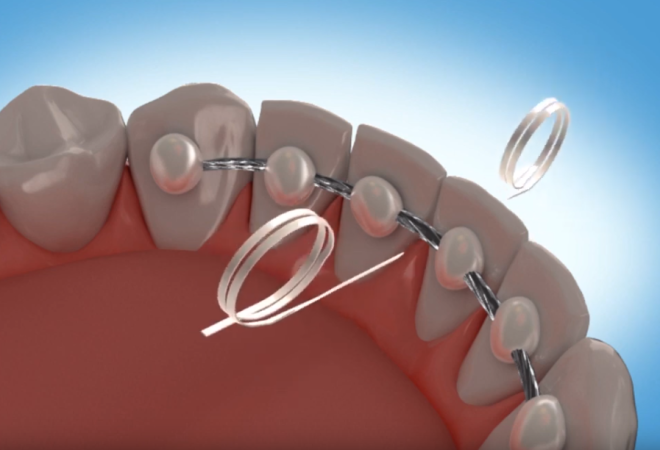Permanent Retainers: The Complete Guide to Pros, Cons, Cost, and Care

Key points
- Constant Retention: It's always working, providing the best defense against tooth relapse.
- Invisible: Since it's bonded to the back of your teeth, no one will know it's there.
- No Compliance Needed: Ideal for individuals who might forget to wear a removable retainer consistently.
- Durable: Unlike removable retainers, it can't be lost, accidentally thrown away, or warped by heat.
After completing orthodontic treatment with braces or clear aligners, the next crucial phase begins: retention. To prevent your teeth from shifting back to their original positions—a process known as relapse—orthodontists recommend retainers. One popular option is the permanent retainer, also known as a bonded or fixed retainer.
While it offers a "set it and forget it" advantage, the reality of a permanent retainer is more complex. This guide covers everything you need to know, from its benefits and drawbacks to cost, care, and potential long-term issues.
What Is a Permanent Retainer?
A permanent retainer is a thin, custom-fitted wire, typically made of metal, that is bonded to the back (lingual side) of your teeth. It is most commonly placed on the lower front four to six teeth, as this area is highly prone to shifting. While they can be placed on the upper teeth, it's less common because the bite can put more pressure on the upper wire, increasing the risk of breakage.
Its primary purpose is to provide continuous retention, holding your teeth in their newly straightened positions 24/7 without requiring you to remember to put it in or take it out.
 Image source: Orthodontic Specialists of White Plains
Image source: Orthodontic Specialists of White Plains
The Great Debate: Permanent vs. Removable Retainers
Choosing a retainer is a significant decision. While your orthodontist will provide a recommendation based on your specific needs, it's helpful to understand the differences between permanent and removable options.
| Feature | Permanent (Bonded) Retainer | Removable Retainer (Essix/Hawley) |
|---|---|---|
| Effectiveness | Highly effective, as it works continuously without relying on patient compliance. | Effectiveness depends entirely on the patient consistently wearing it as directed. |
| Appearance | Invisible from the front. | Clear (Essix) retainers are discreet but can be noticeable. Hawley retainers have a visible wire. |
| Oral Hygiene | Challenging. Requires special tools like floss threaders to clean properly. | Easy. The retainer is removed for normal brushing and flossing. |
| Convenience | No need to remember to wear, remove, or store it. | Must be removed for eating and drinking (anything other than water) and stored safely. |
| Risk | Can break or debond. May lead to plaque/tartar buildup if not cleaned well. | Can be easily lost, misplaced, or damaged if not stored correctly. |
Many orthodontists recommend a combination approach: a permanent retainer on the lower teeth and a removable one for the upper teeth.
Pros and Cons of Permanent Retainers
Advantages
- Constant Retention: It's always working, providing the best defense against tooth relapse.
- Invisible: Since it's bonded to the back of your teeth, no one will know it's there.
- No Compliance Needed: Ideal for individuals who might forget to wear a removable retainer consistently.
- Durable: Unlike removable retainers, it can't be lost, accidentally thrown away, or warped by heat.
Disadvantages
- Oral Hygiene Challenges: This is the most significant drawback. Flossing is difficult and requires tools like a floss threader or water flosser.
- Plaque and Tartar Buildup: Inadequate cleaning can lead to significant tartar buildup, increasing the risk for cavities and gum disease.
- Dietary Restrictions: You must be cautious with hard, sticky, or crunchy foods that can bend or break the wire.
- Potential for Breakage: The wire can break or the bonding agent can fail, requiring an urgent trip to the orthodontist for repair.
- Tongue Irritation: Some people experience initial discomfort or irritation where their tongue touches the wire.
The "Permanence" Paradox: How Long Do They Really Last?
Despite the name, a "permanent" retainer is not guaranteed to last a lifetime. While a well-maintained retainer can last for up to 20 years, the "permanence paradox" lies in its notable failure rate. Research indicates that over a third of bonded retainers may experience failure over the long term.
Factors that influence longevity include:
- Oral Hygiene: Proper cleaning prevents issues that could weaken the bonding.
- Diet and Habits: Avoiding hard foods and not using your teeth as tools prevents damage.
- Biting Forces: A person's individual bite can put stress on the retainer.
- Practitioner Skill: The experience of the orthodontist in placing the retainer is a crucial factor in its survival rate.
Failure typically involves either the wire fracturing or, more commonly, the bonding material detaching from one or more teeth.
The Cost of a Permanent Retainer
The cost for the initial placement or a full replacement of a permanent retainer generally ranges from $150 to $500 per arch. However, some advanced, custom-designed wires (like CAD/CAM retainers) can cost up to $850 per arch.
Often, the cost of your first set of retainers is included in the overall price of your orthodontic treatment. It's important to remember that repairs often cost just as much as a new placement. Be sure to check with your dental insurance provider to see what, if any, of the cost is covered.
Caring for Your Permanent Retainer: A Guide to Oral Hygiene
Diligent oral hygiene is non-negotiable with a permanent retainer. Here’s how to keep your teeth and gums healthy:
- Brushing: Use a soft-bristled toothbrush and be sure to angle the bristles to clean thoroughly above and below the wire.
- Flossing: This is the most critical and challenging step. You cannot floss normally. Instead, use one of these tools:
- Floss Threader: A stiff-tipped loop that helps you thread floss under the retainer wire, allowing you to clean between each tooth.
- Water Flosser: A device that shoots a high-pressure stream of water to dislodge food particles and plaque from around the wire and between teeth.
- Interdental Brushes: Tiny brushes designed to clean in small spaces.
- Regular Dental Check-ups: Schedule professional cleanings every six months. A dental hygienist has the tools to remove tartar that you can't get at home.
 Image source: Premier Orthodontics
Image source: Premier Orthodontics
Potential Problems and Long-Term Health Implications
If not properly maintained, a permanent retainer can lead to several issues.
Health Risks
- Cavities and Gum Disease: The difficulty in cleaning makes the area a prime spot for plaque to harden into tartar, leading to tooth decay and gum inflammation (gingivitis), which can progress to more severe periodontitis.
- Bad Breath (Halitosis): The accumulation of bacteria can cause persistent bad breath.
Mechanical Failures
- Shifting Teeth: If a bond fails on even one tooth or the wire breaks, your teeth can start to shift. It's vital to contact your orthodontist immediately if you feel something is loose or broken.
- The "Twist Effect": In rare cases, a bonded retainer can cause unwanted tooth movement even while fully attached. This phenomenon may involve the canines twisting in opposite directions, potentially leading to bone loss or gum recession. Regular orthodontic check-ups can help catch this early.
The Removal Process: Is It Really Permanent?
A permanent retainer can be removed by a dentist or orthodontist at any time. The process is straightforward and involves:
- Carefully breaking the bonding material.
- Removing the wire.
- Polishing the back of the teeth to remove any remaining adhesive.
It is critical to have a new retention plan in place immediately after removal. Without a retainer, your teeth will begin to shift. This usually means getting fitted for a removable retainer that you will need to wear as directed by your orthodontist.
References
- Medical News Today. (2025). Permanent retainer: Pros and cons, cost, and removal. https://www.medicalnewstatoday.com/articles/permanent-retainer
- WebMD. (2025). What to Know About Permanent Retainers. https://www.webmd.com/oral-health/what-to-know-about-permanent-retainers
- Invisalign. (n.d.). Permanent Retainers. https://www.invisalign.com/resources/retainers/permanent-retainers
- Allure. (2022). What I Wish I'd Known Before Getting a "Permanent" Retainer. https://www.allure.com/story/permanent-retainer-photos-risks-cost

About the author
Benjamin Carter, MD, is a board-certified otolaryngologist specializing in head and neck surgery, with an expertise in treating throat cancer. He is an associate professor and the residency program director at a medical school in North Carolina.